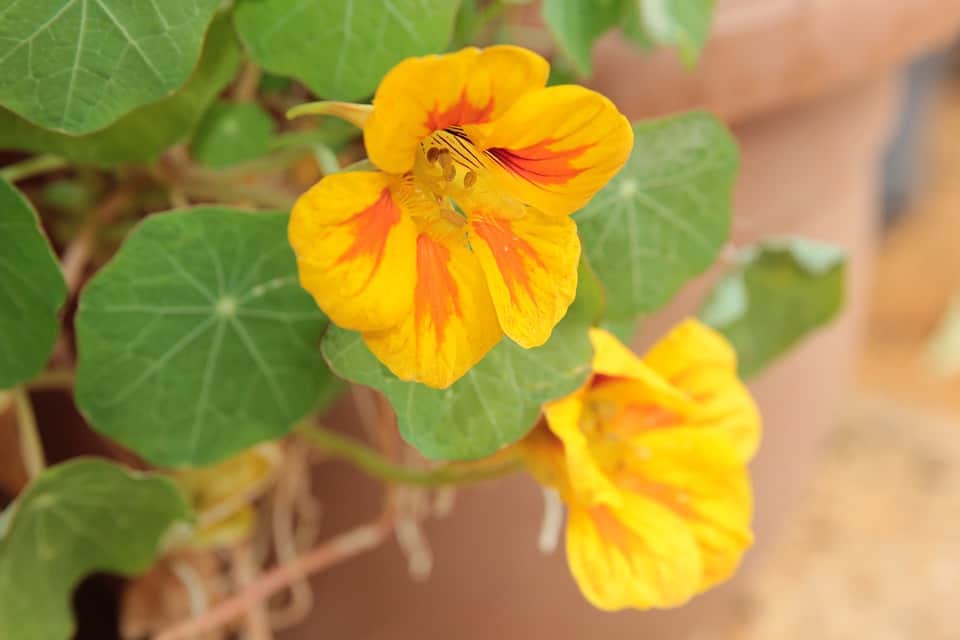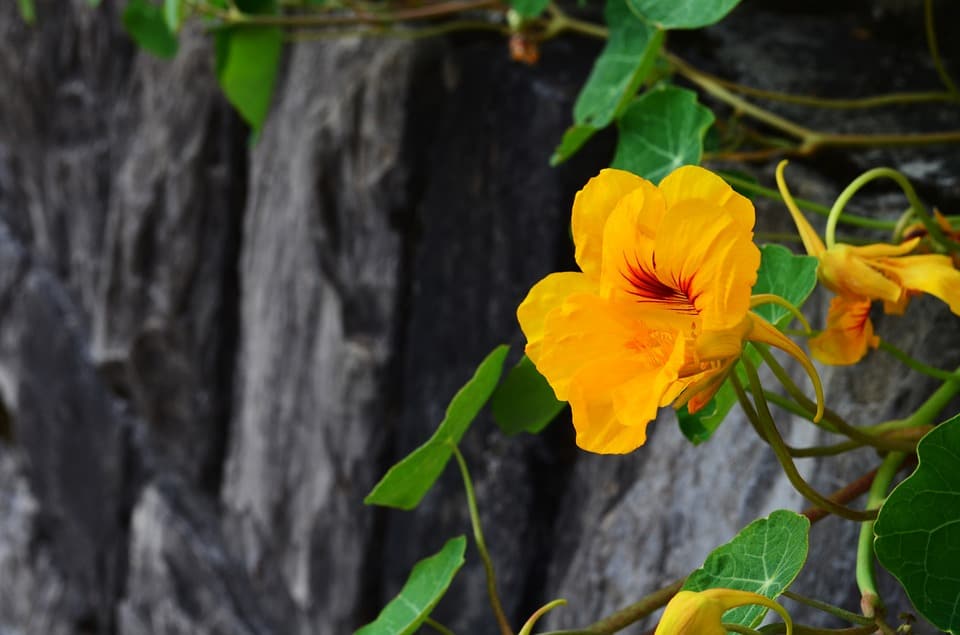Jump to:
Nasturtiums are either annuals or perennials, but neither hardy in the UK. The perennials, though, are easily dug up in the autumn and kept frost-free over winter for planting out the following spring.
Both kinds are invaluable. Use them to fill gaps or shoot over adjacent shrubs, or cover special bamboo wigwams, with the young plants at the bottom being trained up and over.
The Big Spreaders
The following need plenty of space to romp about:
- T. majus ‘Alaska Mixed’: a good value annual with fiery flowers and leaves that are mottled and marbled creamy white. Like the parent T. majus, it’s a prodigious grower shooting up to 3m (10ft) high and wide. ‘Empress of India’ has scarlet-crimson flowers offset by its dark, rich green leaves, while ‘Hermine Grashoff’ is another bright red, albeit better suited to hanging baskets and pots since it isn’t that rampant. The Royal Horticultural Society has given ‘Hermine Grashoff’ its Award of Garden Merit (AGM).
- T. speciosum: the perennial flame creeper from Chile makes high-powered summer growth, reaching 3m (10ft) with a terrific cover of bright red flowers from summer to autumn. Has been awarded the AGM.
- T. tricolor: a slightly more restrained perennial that puts on up to 2m (6ft) of winter-to-early-summer growth, and has flowers with a mix of maroon, orange, red and yellow. It is very tender and either needs a frost-free, sunny, sheltered courtyard or a conservatory. Has been awarded the AGM.
Smaller Varieties

There are many nasturtiums that won’t get out of hand and can be grown in small border gaps or pots:
- T. ‘Glorious Gleam’: a good choice for trailing stems, spreading 45cm (18in) across the ground. The annual Gleam Series comes in a range of colours with pastels, orange, yellow and red.
- T. ‘Jewel Mixed’: small, bushy, annual tropaeolums in pink, yellow, and red, whose flowers have the characteristic spur at the back. They’ll grow to 30cm (1ft) and spread by even more.
- T. majus ‘Whirlybird Mixed’: the Whirlybird Series offers bushy annuals in orange, yellow, pink and red which are quite restrained and won’t exceed 30cm (1ft) in height or a spread of 40cm (16in).
Growing Tips

Site and Soil Preferences
nasturtiums need wall-to-wall sun and average soil that never bakes dry. Consider a greenhouse to better control and moisture levels of your soil. T. majus and T. speciosum tolerate poorer ground.
Sowing Annuals
Annuals can be sown in spring directly into well-weeded soil. Keep a close eye on them and keep watering in dry spells.
Monet’s Path
one of the best tricks is to let nasturtiums grow across a path, instead of making the climb. Monet famously did it at his French garden in Giverny. In early summer, the plants are still in place at the path’s edge but by the end of summer, they’ve swarmed across the track turning into a great length of colour, making it impossible to walk along. Choose a colourful climbing variety, and sow the seeds up both edges.
Propagation
Take shoot tip cuttings, for example of T. majus ‘Hermine Grashoff’, during the summer and pot them up. Keep them frost-free over winter and plant out the following spring, after the last of the frosts.
Tender Perennials
The perennials aren’t completely hardy and need digging up, with their top growth cut off, for storing overwinter in a cool, dry, frost-free garage. They can also be divided at the same time to create new plants.
Problem Solver
Keep an eye out for caterpillars and slugs.










